A crack appears in the fiberglass bottom of the boat each time we hit a wave as we cross Lake Atitlan. It is a cloudy and hazy morning, and I am heading north to Peten, the largest state in Guatemala. It is home to the most largest concentration of Mayan ruins in the country. I can’t wait to get there.
After the boat docks at Panajachel, I walk over to a travel agency to see about getting a ticket to Guatemala City, from where I can catch a bus to the town of Flores. Within fifteen minutes I catch a shuttle and am leaving the Atitlan area. I will miss it.
As we wait to pick up others, I see a boy kicking a small puppy in the yard of his house. The puppy is chained up, and cannot run away. I open the sliding window of the van and yell at him. He stops to look at me, a long-haired bearded gringo glaring at him. We pull away a few moments later and he continues.
I am not so mad at him as at whomever taught him that such behavior was tolerable. In a country where most of the people don’t have enough to eat, kindness to animals is low on the priority list. And I understand that—I feel deeply for those people who struggle just to find their next meal. But I don’t understand someone who allows a small child to abuse a small animal, no matter their circumstances.
For the rest of the ride I sit quietly. We change shuttles buses in Antigua and after dropping folks off at the airport and several hotels, I finally get out and walk to my hotel—I can’t sit inside anymore.
My hotel is nearby, and after checking in I buy a bus ticket for the following day. Overnight buses do run, but I abhor them and figure I’m better off getting a good night’s sleep than having to catch up for the next few days.
By now it is mid-afternoon and I am starving. I have a late lunch, which includes some cheese. For the purposes of this trip, I vowed I would try as much as possible to stay vegan, but would be open to eating cheese in pressing circumstances. In no case would I consider eating meat, though. But as I walk back to my hotel my stomach feels awful, and I don’t feel like eating for the rest of the day.
The next morning I jump on the bus as soon as they open the doors and have a long, if uneventful bus ride. The bus ride ends in Santa Elena, just over a mile short of Flores, but there is an industrious shuttle bus driver there to take us through town and across a causeway to the island of Flores.
Stepping out into the night, I can feel that I have reached the muggy north. Even though the sun set nearly two hours earlier, an oppressive weight of heat and humidity hangs over the town. I am sweating before I can even heft my backpack to my shoulders. But being raised in the American South, I know I’ll adjust to this soon.
With my first two choices booked solid for the night, I get a room at an upscale hotel. For $50 a night I get my own bathroom and a remote controlled air conditioner. Because of my stomach troubles, the former will be a great luxury, and is the first time I’ve had a private bathroom during this trip.
As soon as I settle into my room I start pounding water. I’ve barely had a liter all day, so now it’s time to catch up. While brushing my teeth I can feel the heat coming off the bathroom tile. Just before turning off the lights I hit the A/C, which feels amazing.
The next morning I wake up with a headache and a sour stomach. I’d wanted to go to see the ruins at Tikal today, but feeling like this, all I want to do is lay in bed. After drinking more water, I venture out of my room to a nearby patio overlooking Lago Peten Itza. It’s only eight in the morning, but is already hot.
As I walk around the small island town, every restaurant and store is closed. I realize it is Sunday morning, so I might be out of luck. Around the next bend, though, I see a place advertising breakfast. Two tourists are sitting up front, which means I am in luck. I don’t feel like drinking coffee, but the fruit salad sounds delicious, so I order it.
Gulls and a Great Egret fly over the nearby lake. Coots bob in the water along the shoreline, which is a low stone wall several feet above the lake surface. After nine hours in a bus yesterday, this place feels like heaven.

From my perch overlooking the lake I can hear them slicing the fruit, so I am nearly drooling when the waitress brings it to me a few minutes later. It is delicious, and after I’m finished I feel much better. I complete a loop around the island, then check a nearby hostel about a room for the night.
Not only do they have a private room available, they also have a tour leaving for Tikal at noon, just an hour and a half away. The negative energy from earlier is dissipating, replaced by a sudden surge of positive. I’m catching the breaks now and just thinking about it raises my spirits.
After I move my stuff over to the new hostel, I get ready to go to Tikal. I am incredibly excited: this excursion is one of the reasons I came to Guatemala.
I can’t recall when I first heard of Tikal, but it’s been on my radar since childhood. In the first Star Wars movie (Episode IV: A New Hope) it appears near then end, just before the scene wherein Han Solo and Luke Skywalker are given an award by Princess Leia.
For a few seconds, the viewer can see the tops of gray stone pyramids above a jungle. Even though Star Wars takes place in a futuristic time, somehow the setting fits in well with the movie. Perhaps it brings more of the mystical element to George Lucas’ story.
Many years later, when I was researching a trip through Mexico and Central America, Tikal popped up again. It is the most famous attraction in the country, and once I found out it was the scene featured in Star Wars, I knew I wanted to visit there.
And now that I’m going to Tikal, I am bouncing off the walls. As I wait in the lobby for the shuttle bus to arrive, several others arrive to wait with me. Excited, I pace around the lobby until the shuttle bus arrives. Then we board and make a quick lap through town to pick up any stragglers. A brightly dressed Brit sits across from me, and we chat as we leave town, headed east.
We drive along Lake Peten Itza for a ways, which looks inviting in the midday heat. After we pass around the east end of the lake, we turn north into the Maya Biosphere Reserve, which is supposed to be protected from development. But in a poor country with a burgeoning population, the pressure to clear more and more of the reserve is mounting.
But when we reach the park boundary, it is clear that the government is intent on protecting this, it’s national gem: the guards are all armed with machine guns. We hop out to buy our day tickets, then get back on the bus to drive to the visitor center.
I’ve brought my binoculars, and the sight of birds flitting and flying across the road ahead of us is nearly as exciting as visiting the ruins. Over 400 species of birds have been recorded at Tikal, and there’s even a bird identification book just for the park. It birding parlance, it might very well be a bird buffet.
At the visitor center, we stop and gather up beside a model of the site. Our guide provides a quick overview of the grounds and where we’ll be walking. Then we’re off into the site proper. My heart is pounding.
We go through a station where a hole is punched in our tickets, then pass through a gate where one man stamps each ticket, then passes it to another man who records the number. No shortage of bureaucracy here.
Ahead the path leads into the forest, and I walk to the front of the group (about twenty strong) to catch a glimpse of some of the birds I can hear in the trees. Our first stop is at a Ceiba Tree that towers over the rest of the nearby forest. The diameter of the base must be four and a half to five feet thick. Bromellids grow plentifully in the branches far overhead.
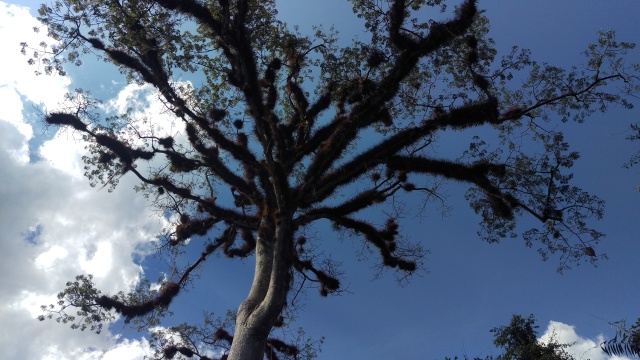
After the tree we continue on, stopping at an intersection to watch some Howler Monkeys groom each other on a branch fifty feet up in a tree. Nearby a medium-sized raptor sits on a branch. Our guide, also carrying binos, glasses it and announces that it is a Roadside Hawk, a new bird to me. It stays still for only a couple more seconds before the camera flashes scare it off.
Continuing on, I see a pair birders from another group and slide in quietly behind them to see what they’re looking at. A Wood Thrush hops on the ground, while a woodpecker and a woodcreeper alight on nearby trees. I take some pictures and then spot a new bird: a Lesson’s Motmot, perched motionless on branch. Even in shadow, the turquoise head really stands out. I’m greatly enjoying this outing so far and we haven’t even gotten to the ruins yet.
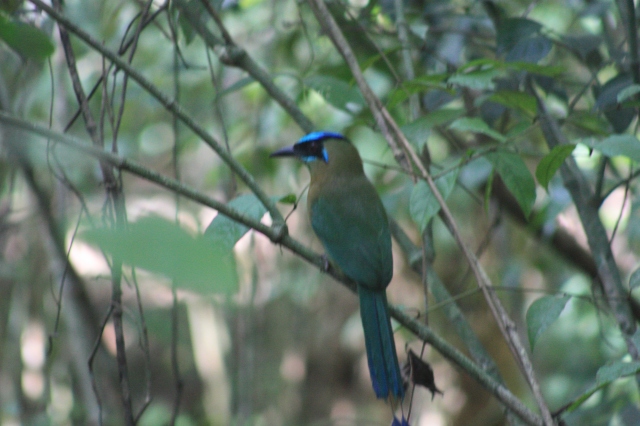
After just a few more minutes of walking we reach the first plaza. Because of the scale of the site, many of the buildings aren’t restored and likely never will be. Looking at the unrestored buildings, I can only imagine the intensive work that must go into the restoration. The restored buildings, many of them pyramids, are incredible. We climb the first one we come to, then the guide tells us all about it.
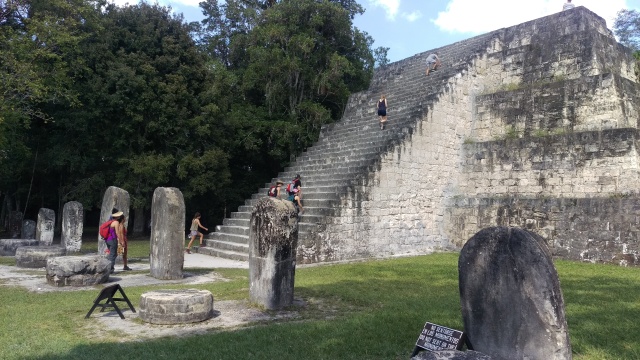
At the foot of the pyramid are seven stelae, stone blocks that look like headstones, only taller. In front of each one is a small round boulder, to hold offerings on special occasions. I marvel at the amount of work it must have taken to move each block and boulder into place here, without the benefit of modern technology, or even the wheel.
Between the plazas we walk through thick forest, so I fall behind to look for more birds. Most of the time I just catch glimpses, but not enough to identify what I’m seeing. I’m not discouraged, though. I’m just happy to be here.
We visit several different plazas before we reach Temple IV, which is the tallest building on the site. We approach from the east side and can see it looming over the forest. At the foot of it is a large sheet of visqueen, covering the work of archaeologists studying the site. We walk around to the west side where there is a wooden stairway that leads to the top. The stairway is there both to protect the pyramid from too much human damage, as well as help those less athletically-inclined get to the top (the original stairs are quite steep and surprisingly tall).
Stuck at the rear of the group, I wait impatiently for those ahead to move on up the stairs. But as soon as I round the corner and catch a glimpse of the view, that impatience and annoyance falls away.
Before me are three towers rising above the jungle that extends to the horizon. Though this temple is usually climbed for sunrise, as it faces east, the light this afternoon makes the view that much more striking. As I stand and gaze across all that I can see, I find that I’m smiling. This is exactly where I want to be.
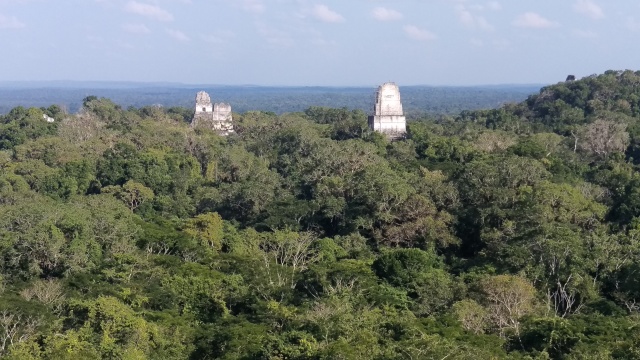
I’ve dreamed about standing here not only for the past few weeks of traveling around this country, but also through months of a cold, dreary Idaho winter. And perhaps longer than that, too.
The view is not so beautiful as it is sublime. These monuments of man that were so laboriously constructed here imbue the place with a feeling of power, as if the towers themselves have conquered the wild jungle around us.
After taking pictures, I find a place to sit off to the side and simply stare. Looking at the smiles of some of other folks on the tour, I know they’re feeling the same as me.
We stay for quite a while. Despite our guide’s subtle pleas to get moving to catch the sunset from another location, we linger there at the top of Temple IV, entranced. A trio of Brown Jays joins us, perhaps to watch the shadows lengthen over the temple tops and trees.
With reluctance, we all seem to get up at the same time and follow our guide down. In a courtyard near the foot of the stairs, a man is selling cold drinks from a cooler. The air isn’t quite so hot as when we started, but I am still sweating. Several of the group by beers to take to the next stop: El Mundo Perdido.
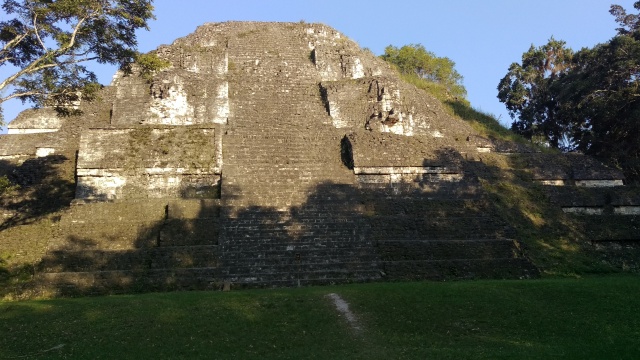
El Mundo Perdido, or The Lost World, is the site of the astronomical observatory for the complex, which consists of several older pyramids. One of them has been added to four times over the course of the Mayan years. Scientists eager to figure out more about their civilization have drilled holes all through the pyramids, only to find them all solid, except for one. Inside one of them was a scale model of the complex, along with a picture or sculpture (I couldn’t hear which) of two men engaged in a rather intimate act. The shocked people who found it thus named the complex the Lost World.
As the guide gives his two cents on the morality of that, most of us climb the pyramid. Though the view from the top isn’t as spectacular as from Temple IV, I see two Collared Acararis: my first toucans.
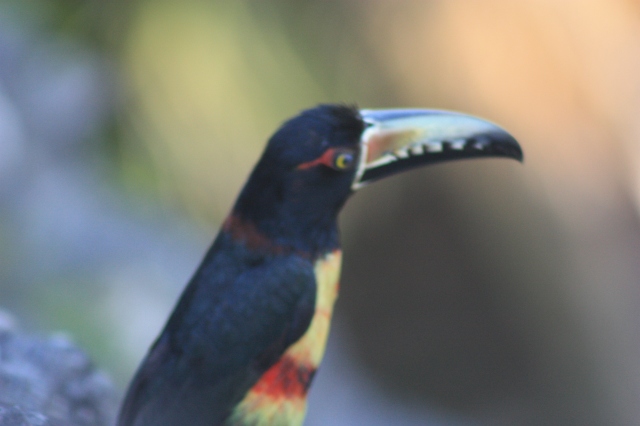
After we descend we see more toucans, this time the Keel-billed Toucans, the mascot of Fruit Loops. They look ridiculous with their long, mostly yellow beaks and red bums. But, they are also captivating and bigger than I thought. I pass around my binoculars while I take photographs, eager to share beauty of the birds with the others. Our guide calls them “Flying Bananas”, and once they take off, I see why. I am thrilled.
After most everyone gets to see the Keel-billeds, we move on to the North Acropolis for sunset. Most of the temples here have been excavated, and thus, are clear from other overgrowth. At the west and east end of the courtyard are the Temples of the Sun and Moon. The former faces east (and is scalable), while the latter faces west (and is off-limits).

It’s not every day that I get to climb a Mayan temple, several others and I head to the Temple of the Sun for a quick look. From there I can see back to Temple IV, as well as the whole acropolis around me. But the shadows are growing long, so I head to the rest of the group, who are sitting on the steps of building at the north end of the acropolis.
As the sunlight wanes, swallows emerge to feed on the plentiful bugs around us. I eat a snack and talk with my new friend Liz from Holland as we watch the sun slowly sink into the trees to the west. Not only do we have a view of the sunset, but also the two temples on either side of the courtyard. It is a magical place to be this time of day.
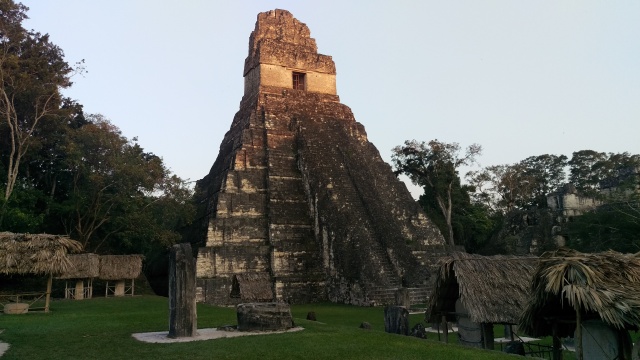
A few minutes after the light is gone, our guide beckons us to start gathering up and heading out, lest we be slapped with a hefty extra fee for staying late. As we wait in the courtyard, I admire the Ocellated Turkeys that are feeding in the short grass. They look like peacocks with the large tails, and even in the twilight their colors are iridescent.
I venture off to get a closer look at another new bird, a Montezuma Oropendola. My bird guide says its song is “liquid, electric,” which describes it well, in addition to “loud”. I’ve never heard any bird like it.

Getting frustrated with the slow-movers, the guide says we are going and points us down a dark path into the trees. I have no idea where we are, nor a map, but I do see some folks in white ahead, so I follow them. Luckily, the knew where they were going, as we emerge at the gate about twenty minutes later.
Even though we were told that anyone leaving the park after 6 would be charged extra, no one is there to enforce it. As we load up in the shuttle bus, I hear another Oropendola sing from a nearby tree. It’s magical call sums up the day, in a way.
For the hour ride back to Flores I put on my headphones and listen to Pearl Jam. The windows on the bus are open, allowing the warm air to blow through and cool us down.
This has been one of the best days of my trip so far. I wish I could describe Tikal better, but it is one of those places that defies mere words.
Simply put, it is a place of power. I might go back tomorrow.

Reblogged this on msamba.
LikeLike
Pingback: Leaving Guatemala – Matt Dunn Online